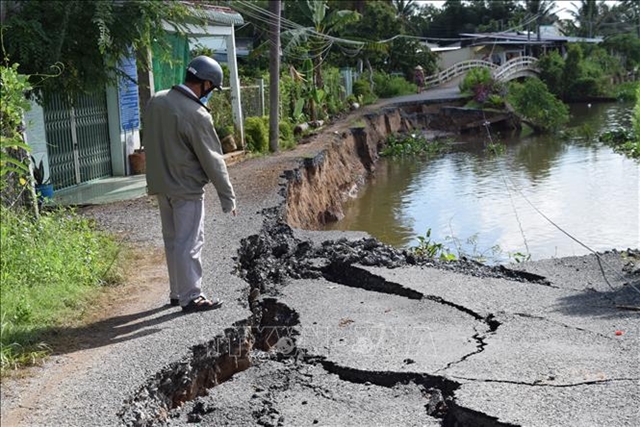 |
| Prolonged heat waves and related disasters such as droughts, land erosion and saltwater intrusion, are affecting farming and people’s lives in the south. VNA Photo Chương Đài |
The region has been unusually warm since February.
In Long Khánh and Biên Hòa Cities in Đồng Nai Province and Đồng Xoài City in Bình Phước province, the average temperature has been over 37 degrees Celsius.
Monitoring stations in Thủ Dầu Một City in Bình Dương Province, Nhà Bè District in HCM City, Vĩnh Long Province, Cao Lãnh City in Đồng Tháp, and Thổ Chu Island in Kiên Giang Province have also recorded unusually high temperatures.
While a few locations have received scanty rainfall of five to 10 millimetres, others have seen none.
Heat waves in the region typically start in mid-February, but this year's have occurred earlier and covered a larger area because of El Niño, experts said.
The weather was chilly with mist in the mornings during the first half of February, thanks to cold air from the north.
But it got hotter by the end of the month as the cold air weakened and hot air flowing from the east increased.
Intense heat waves will continue to occur in the south-eastern and south-western region, the National Centre for Hydrometeorological Forecasting (NCHMF) said.
In March the average temperature is forecast to be 0.5-1.5 degrees Celsius higher than normal, and there will be very sporadic showers.
More prolonged heat waves are expected, and temperatures in the south-eastern provinces could reach 39-40 degrees Celsius, Nguyễn Văn Hưởng, head of the NCHMF’s weather forecast division, said.
April will be the peak heat period, with 15 to 20 extremely sunny days.
The rainy season is expected to start in May, but there will still be occasional hot periods with temperatures of 35-37 degrees.
The prolonged heat waves and dryness have led to more severe saltwater intrusion in rivers and erosion in southern agricultural areas, experts said.
The Mekong Delta has been facing land subsidence and erosion due to the low water levels in rivers and canals.
Localities in the delta, central and central highlands regions, which are most affected by the heat waves, should pay close attention to meteorological, drought, and saltwater intrusion forecasts, and take preemptive measures, experts said.
It is also crucial to ensure water security and encourage people to use water carefully.
In Sóc Trăng Province, its Steering Committee for Natural Disaster Prevention and Control, Search, and Rescue has designed a plan to prevent and handle possible disasters in areas that are low-lying or prone to subsidence.
It has also allocated funds to handle erosion in the Saintard (Long Phú District) and Phụng An rivers (Kế Sách District) and build an embankment in Vĩnh Châu Town.
Kiên Giang Province’s Steering Committee for Natural Disaster Prevention and Control, Search, and Rescue has recently adopted WebGis to provide rapid updates on erosion in rivers and along coasts.
WebGis is an online map website that integrates the geographical information system, which allows authorities to build a warning system with stations for meteorology, measuring saltwater intrusion, water level monitoring, rain level.
The Ministry of Natural Resources and Environment wants localities to carefully monitor the effects of El Niño and local weather conditions and stay alert for possible droughts, water shortages and saltwater intrusion.
It is also important for the public to actively take preventive measures, it said.
The Ministry of Agriculture and Rural Development also urged local authorities to have practical, weather-adaptive agricultural practices to minimise the effects of droughts and saltwater intrusion. – VNS